Bluebirds are Everywhere in Bickleton
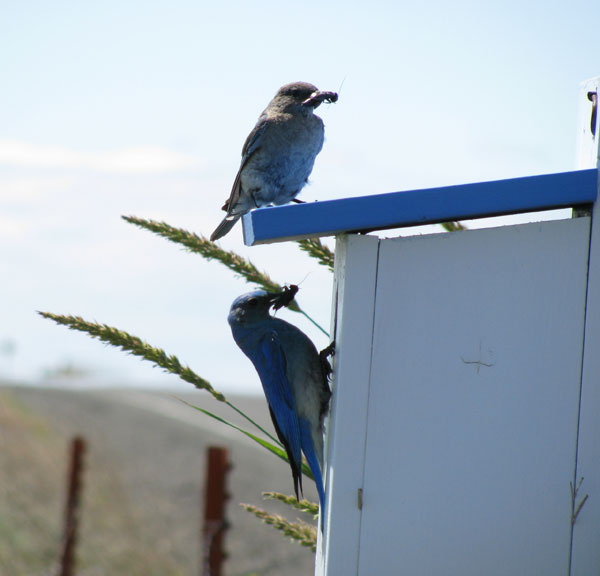
While on work travel, I took a Saturday morning off and headed out to Bickleton, of south central WA, population 113 (as of the year 2000) to see the Bluebirds of Bickleton. Bickleton is actually the first place I ever saw a bluebird.
In 1968, Jess and Elva Brinkerhoff traveled from Richland, WA to Bickleton to see wildflowers. (Source of date: The Return of the Bluebird, forward by L. Zeleny.) “The Brinkerhoffs spotted one of these graceful companions of summer. Hoping to encourage it to stay, they rescued a metal coffee can from the local dump to make a rough birdhouse and nailed it to a tree. As they stood by watching, two bluebirds moved right in.” (Source: An American Profile.) The Brinkerhoff’s received the John and Nora Lane award from the North American Bluebird Society for outstanding contributions to bluebird conservation in 1983. Elva passed away in 1985, but her legacy lives on.
The Brinkerhoffs (and others?) installed more than 2,000 (?) wooden bluebird houses in and around Bickleton over the next four decades. Bickleton bluebird brigade volunteers (residents, farmers, school children, etc.) build, clean, repair and paint the boxes. Some funding is obtained from souvenirs sold at the Whoop-n-Holler Museum (which I intend to visit on my next trip).
Most of the boxes are mounted on fenceposts; some are mounted on trees or buildings. Many are painted white, with blue roofs. Some are made in a style not well suited to monitoring (see photos), but they are probably only cleaned out once a year at the end of the season. Some are in disrepair, others are in excellent condition. None that I saw are paired. But most importantly, the majority are are occupied! Most boxes contained bluebirds, were fewer Tree Swallows, and some House Wrens. I did see a several nesting House Sparrows near residences or farms.
I read that both Mountain and Western Bluebirds nest in Bickleton – I only saw Western Bluebird adults. The town claims to be the “bluebird capital of the world.” It is certainly the first place I ever saw Western Bluebirds.
– Bet Zimmerman, June 20, 2009
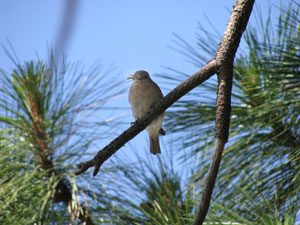
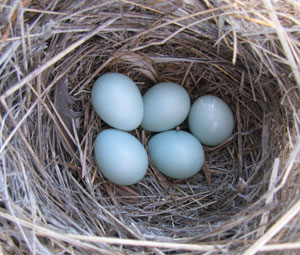
Above: Left – A female Western? Bluebird with an unidentified bug in her beak. Right – Neatly shaped cup with Western Bluebird eggs, which appeared to be a paler blue than Eastern Bluebird eggs. Two feathers in this nest – Western Bluebird nests sometimes contain many feathers and trash. See more photos.
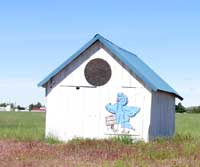
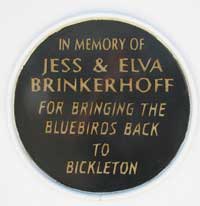
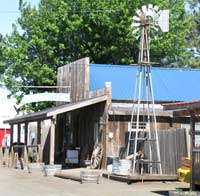
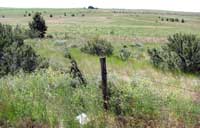
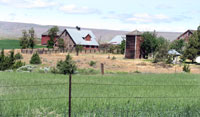
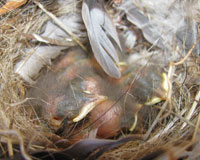
Related topics:
- The History of Bluebirding, Sialis.org
- Bluebirds Are Everywhere in Bickleton, WA, Villager Newspapers
- Western Bluebird Bio
- Mountain Bluebird Bio
- About Bickleton, WA and Bickleton Bluebirds
- The Brinkerhoffs, American Profile
- Bluebird nestlings
- Western Bluebirds at the Spa – photo
- Western Bluebird nests, eggs and young – photos
- Sialia journal (NABS), Vol.3, No.1, Winter 1981
- Sialia Journal (NABS), Vol.5, No.1, Winter 1983
- Bluebirds and Bloodlines, Seattle Times
- Forward written by Larry Zeleny for The Return of the Bluebird by Andre Dion
- Being Blue in Bickleton: Town attracts bluebirds from Mexico, Tri-City Herald, 04/26/2009
Previous Pictures of the Week: © Original photographs are copyrighted, and may not be used without the permission of the photographer. Please honor their copyright protection. If you would like to use a photo for educational purposes, you can contact me.
- Tips for photographing cavity nesters
- June 11, 2006 – Great Crested Flycatcher
- June 19, 2006 – Snake Lick
- June 26, 2006 – House Finch Nest
- July 3, 2006 – Tree Swallow in Flight
- July 17, 2006 – Bluebird Battle
- July 24, 2006 – Bear Attack
- August 1, 2006 – Neglected Nestboxes (House Sparrow nests)
- August 14, 2006 – Threesome (Bluebird Babes)
- August 28, 2006 – Peering (flicker)
- January 2007 – New Hill Trail (Sialis)
- February 12 2007 – Sharp-shinned? Hawk feeding on dead starling
- February 19, 2007 – Joe’s Cafe (Suet/Mealworm Feeder)
- March 25, 2007 – Sunflower Eater
- February 2007 – Snags & Suet (Pileated Woodpeckers)
- May 2007 – Birdcam Shots and Birdcam Photo Album
- May 12, 2007 – Carolina Wren nest in a boot
- May 25, 2007 – Batman Bird (Tree Swallows)
- June 2007 – Bluebird nest of cattails, one with leaves, and a TRES nest with maple seeds
- June 20, 2007 – Nine Egger (Tree Swallow nest)
- June 27, 2007 – Black-capped Chickadees (funny and serious photos)
- July 7, 2007 – Anting and Sunbathing
- Red-shouldered Hawk perching on nestbox
- November 18, 2007 – Western Bluebirds at the Spa
- March 15, 2008 – Under Construction – Eastern Bluebirds Building a Nest
- April 9, 2008 – Bluebird Battle in PA
- April 10, 2008 – Mouse Surprise
- April 15, 2008 – Bluebird News (nest in paper box)
- April 23, 2008 – My personal nightmare
- April 25, 2008 – Brave White-breasted Nuthatch
- April, 2008 – How an egg hatches
- May 3, 2008 – Newborn Blue (baby hatching)
- May 3, 2008 – Brave Blue (female on nest)
- May 14, 2008 – House Wren Havoc (eggs pecked)
- May 25, 2008 – House Wren Takeover (of nest, more pecked eggs)
- May 29, 2008 – Take Your Pick (parents feeding fledgling)
- June 10, 2008 – That Look Belongs in a Holster (female MOBL)
- August 23, 2008 – Cat on Nestbox
- September 28, 2008 – HOSP on the House
- October 10, 2008 – Cuddling nestlings (taken in summer time)
- October 27, 2008 – HOSP in flight
- October, 2008 – Possible double and dwarf egg in one nest
- December 16, 2008 – The Next Generation (children building boxes)
- January 22, 2009 – Blue with Cold
- January 28, 2009 – Prothonotary Warbler on a camper | Nest building PROW | PROW nesting in tree cavity
- May, 2009 – To Kill a Mockingbird (Snake eating mockingbird – may be disturbing)
- May 21, 2009 – Should I Stay or Should I Go Now? (Titmouse nestling in box)
- May 25, 2009 – Which of these is not like the others? (Cowbird egg)
- May 23, 2009 – The Honeypot at the end of the rainbow (bumblebee nest)
- June 20, 2009 – House Wren nest decorated with Western Bluebird feathers
- June 20, 2009 – Wonderful WEBLS of WA
- June 20, 2009 – Bluebirds of Bickleton
- July 12, 2009 – Hairy Shrimp (newborn bluebirds)
- July 2009 – Diet (bluebird with earthworm in beak)
- July 2009 – Bluebirds nesting outside of cavity
- July 19, 2009 – HOSP on Holiday
- July 20, 2009 – Pink bluebird eggs
- August 2, 2009 – Pinkies (baby mice)
- August 2, 2009 – En garde (male bluebird in box)
- September 29, 2009 – 1917 instructions for bird house construction
- I forget when – Rainbox
- April 11, 2010 – nuthatch bark
- April 12, 2010 – My first white egg
- April 12, 2009 – TUTI nest by Keith Kridler
- May 2010 – TUTI newborns
- May 2010 – Christmas Chickadee
- May 2010 – Bluebird and Chickadee eggs in the same nest
- June 2012 – Paparazzi
- April 2013 – Under Construction – Titmouse nestbuilding
- July 2013 – Pink Bluebird Eggs
- July 2014 – Cowbird egg in Eastern Bluebird nest
- July 2014 – Newborn HOSP
- July 2015: Patience Pays (Male Eastern Bluebird)
You cannot begin to preserve any species of animal unless you preserve the habitat in which it dwells. Disturb or destroy that habitat and you will exterminate the species as surely as if you had shot it. So conservation means that you have to preserve forest and grassland, river and lake, even the sea itself. This is vital not only for the preservation of animal life generally, but for the future existence of man himself—a point that seems to escape many people.
-Gerald Durrell, The Nature Conservancy
